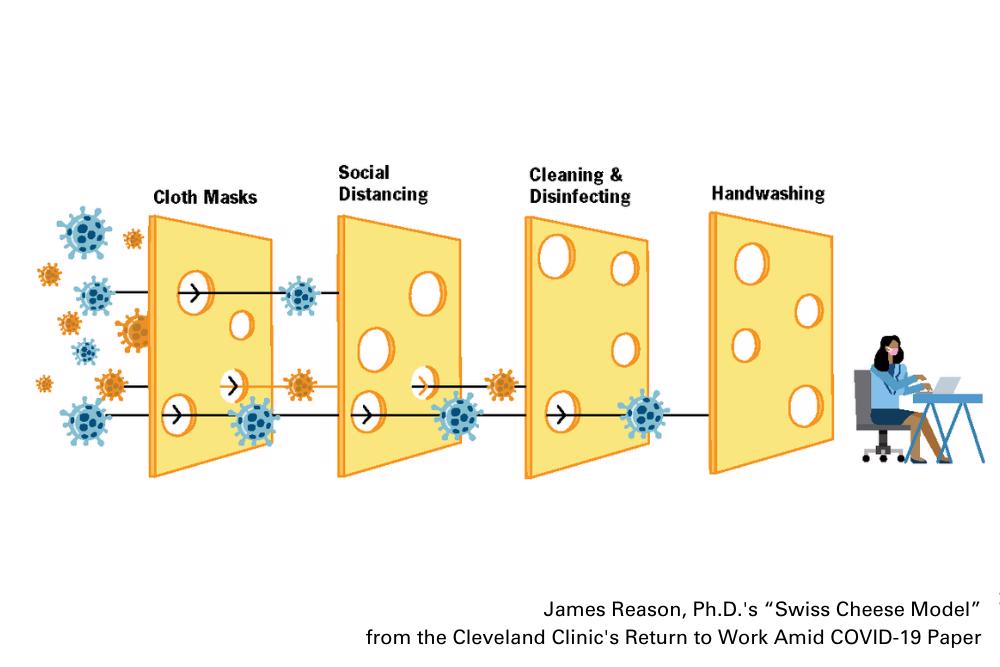Who could have imagined how quickly our world could change? The global pandemic struck and instantly affected everything in our lives. From how and where we work, shop, eat and play to our personal connections with the people in our lives, COVID-19 has left us frightened, challenged and, at times, overwhelmed.
In this Together, Changing Our Workplace Models
It helps to know that we are not in this alone. Companies all over the world are making adjustments to keep their employees safe and their businesses financially viable. In order to make employees feel confident in returning to office space, health guidelines need to be in place.
In a Cleveland Clinic paper entitled
Return to Work Amid COVID-19, an interesting safety model is highlighted. From the article:
“In 1990, James Reason, PhD, introduced the “Swiss Cheese Model" that has been adopted to improve safety across many industries. In any work setting, there are inherent risks. Most of the time these risks are never realized because safeguards are in place to prevent them. These safeguards are represented in his model as multiple layers of swiss cheese. However, every process has “holes" that, under the right circumstances, can line up and lead to an error, accident or “hazard" as Reason described it.
“The COVID-19 pandemic requires multiple layers of protection to keep the workplace safe. These layers of swiss cheese serve as safeguards for your organization and your people. When used together consistently, the holes (or weaknesses) in any single layer of protection should be offset by the strengths of another layer of intervention.
“Per Reasons model, the more layers of effective interventions that are implemented, the less likely your business will contribute to the spread of COVID-19. For example, face coverings can slow the spread of COVID-19 and help prevent pre-symptomatic carriers from unknowingly transmitting it to others. However, no mask is 100% effective. Maintaining six feet from other individuals in your workplace is an effective way to reduce transmission of the virus, but may not always be possible. Cleaning and disinfecting equipment is extremely important, but it is impossible to keep a surface completely disinfected between cleanings. Frequent handwashing is essential to prevent the spread of the virus, and is just one element of a larger infection prevention strategy. While any one of these interventions is not perfect, when used in conjunction with a broader range of safety practices, the risk of COVID-19 transmission is significantly reduced.
- incorporation of highly-visible sanitation stations throughout the office for use and to provide reassurance
- addition of screens or dividers as needed to enhance social distancing
- provisions for appropriate collaborative settings that support creativity, allow for social distancing and offer virtual connectivity for those working elsewhere
- flexibility for employees to work from home as needed
- creation of more robust ventilation systems
- cleanable surfaces
- dedicated spaces for deep focus and concentration
- use of outdoor amenities as workspace
- incorporation of smart technology to measure and adapt spaces due to usage
Many of you are hungry for answers, and we can guide you by introducing new methodologies. We can offer real-time solutions and services as you re-introduce employees to your spaces.
COVID-19 Driving Change Across Sectors
And it doesn't stop at office design. Our multifamily, student living and senior living projects are also being modified to ensure health and safety in these denser populations.For example, we recently made significant changes to the interior design solutions for 1919 Mile High Apartments in Denver, Colo. Laura Waller, who is leading interior design for the project, says, “Typically during the programming phase of our multifamily projects, we would implement as many social spaces as we can into the amenity areas. Then the COVID-19 pandemic hit, and we knew we needed to reconsider our original assumptions. Instead of focusing on communal spaces, we have incorporated individual work zones and offices in an effort to provide alternatives for those residents who will be working from home. We also created smaller, more intimate gathering spaces in our club rooms and lobbies so that more people can use the rooms simultaneously without having to interact closely with others. As the project develops further, we plan to install hand sanitizer stations in areas that will be heavily used, ensuring the residents will recognize that safety and cleanliness are of utmost concern in their new home."
This is just one example of how interior design continues to affect the project and its occupants.
Obviously, change can be difficult, but change comes nonetheless. As we all continue to understand this new normal, you can count on Opus to help you navigate these changing times.
And let's continue to take care of one another.
